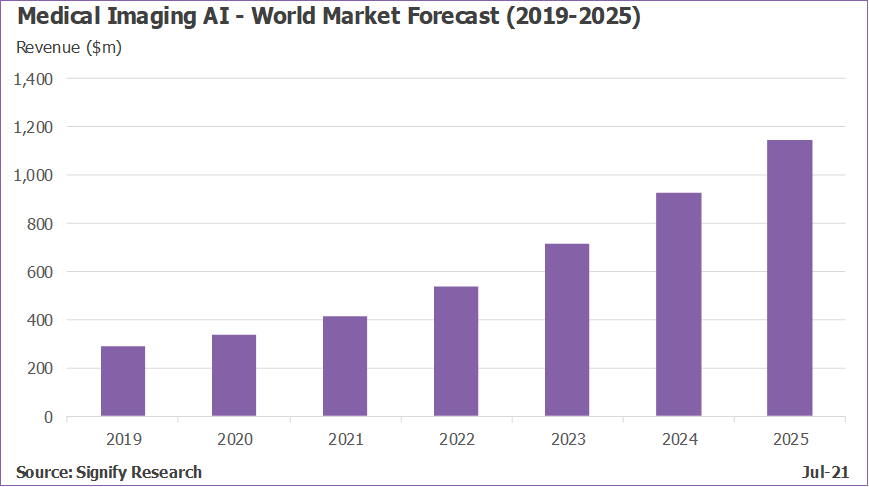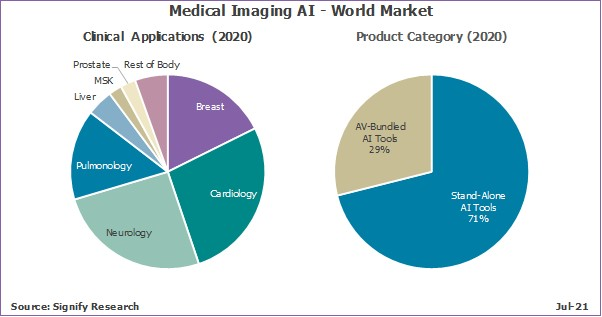27th
July 2021 – Written by Sanjay M Parekh, PhD, The world market for medical
imaging AI applications is projected to reach almost $1.2 billion by 2025
with a CAGR of 26%, an increase of over $800 million from the market size in
2020.
Despite the COVID-19 pandemic, there have been several positive
developments for the medical imaging AI market in 2020 and 2021 (to date).
These include new product launches (a record number of AI solutions received
US-FDA clearance in 2020), new reimbursement codes (such as the New
Technology Add-on Payment reimbursement for stroke imaging AI in the US), and
the first wave of Class III NMPA approvals in China (permitting the use of
medical imaging AI solutions for diagnostic purposes).

Figure 1: Signify Research’s forecast for the medical imaging AI world
market (2019 – 2025)
However, several barriers are still holding the market back and need to be
addressed. These include the limited number of clinical validation studies
that show the efficacy and efficiency of AI solutions and limited real-world
studies to demonstrate the health economic benefits of AI, to name but a few.
For the market to go on and reach its full potential, customers need to know
the impact of using AI in the real world, have greater confidence in AI
technology, and need to know the value and the return on investment for
AI.
Stand-alone AI software applications account for most of the medical
imaging AI market (Figure 2), but one-third of this market is accounted for
by AI tools bundled on advanced visualisation (AV) platforms. However, the
market for stand-alone AI applications (CAGR 31.9%) is forecast to grow
faster than the market for AV-bundled AI tools (CAGR 3.9%) and will account
for almost 90% of the total medical imaging AI market by the end of the
forecast period (2025).
Most of these software applications and tools are targeted at four clinical
applications (Figure 2), which account for most of the medical imaging AI market
(85%). These clinical applications are (in order of market size): cardiology,
neurology, breast, and pulmonology, and are projected to still dominate the
market in 2025 (82% of total revenue). While the number of new product
introductions of AI solutions for other clinical segments is on the rise,
most notably for prostate and liver imaging, the lack of reimbursement will
initially hold back market uptake of these newer solutions.

Figure 2: The medical imaging AI world market (2020) split by clinical
applications (left) and product categories (right)
Despite some scepticism and suggestions of an AI winter, this remains an
exciting market with medical imaging AI becoming an increasingly important
technology within radiology. Most medical imaging AI vendors remain focused
on automating image analysis and improving workflow efficiencies. However, in
the mid-to-longer term, market growth will depend on vendors delivering value
beyond the primary read, for example, identifying incidentals to avoid missed
diagnoses, using quantitative imaging to reduce the need for biopsy, or
reducing the turn-around time for critical cases such as stroke care.
Vendors may also look beyond radiology, for example by developing companion
diagnostic tools in a bid to partner with pharmaceutical and medical device
companies, or population health tools to aid healthcare providers diagnose
chronic conditions earlier, enabling better treatment and management of these
patients. Ultimately, the solutions that significantly improve patient care
are most likely to be those that receive reimbursement and drive market
growth.
|



